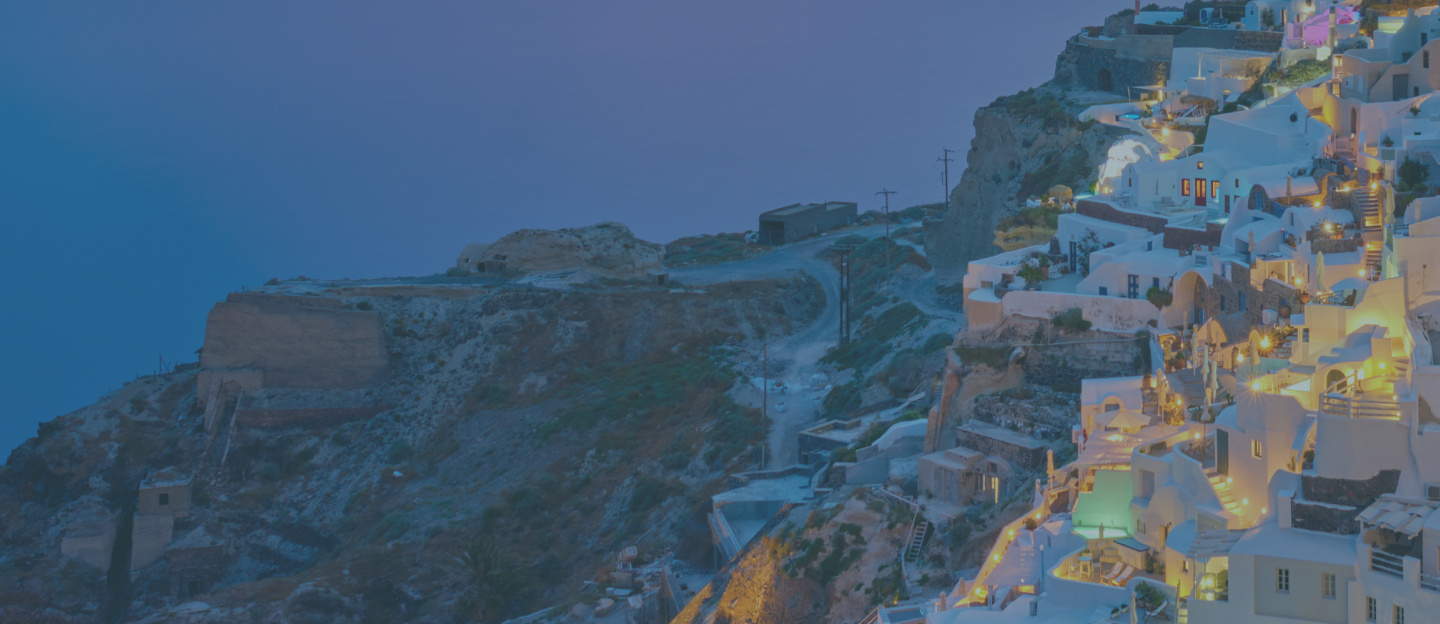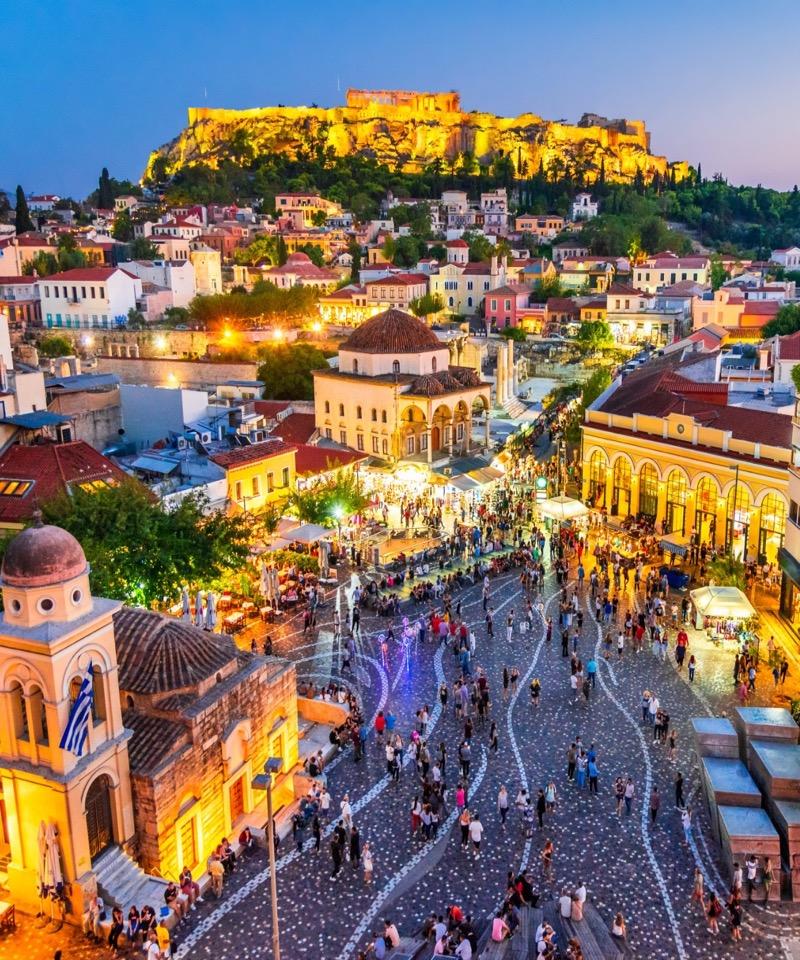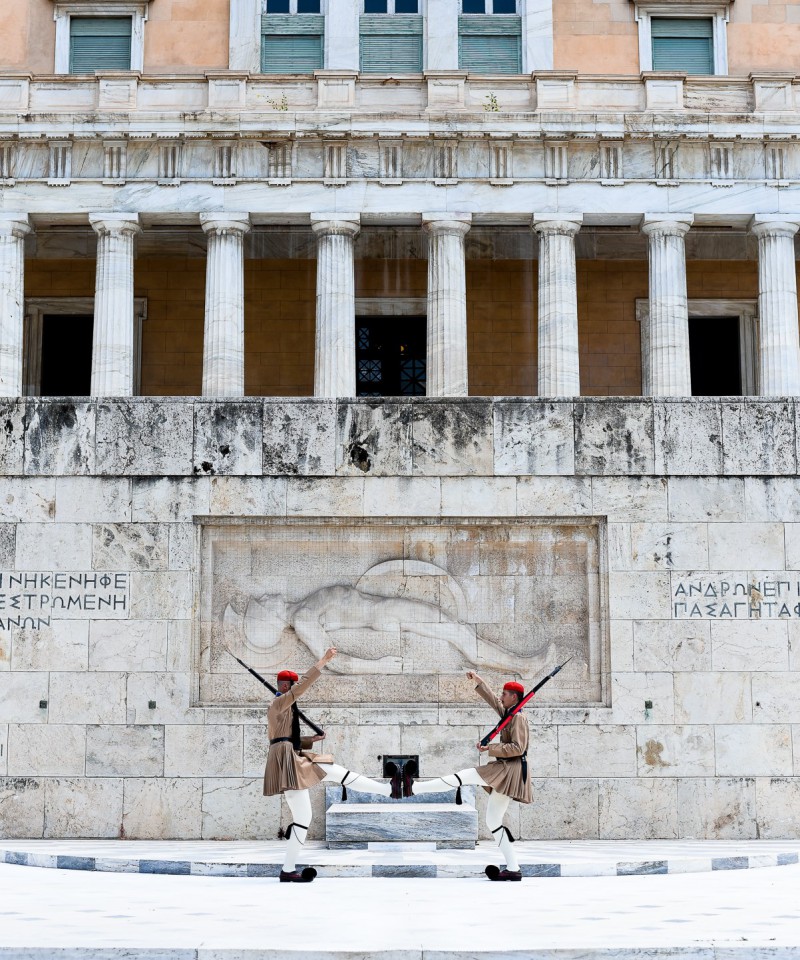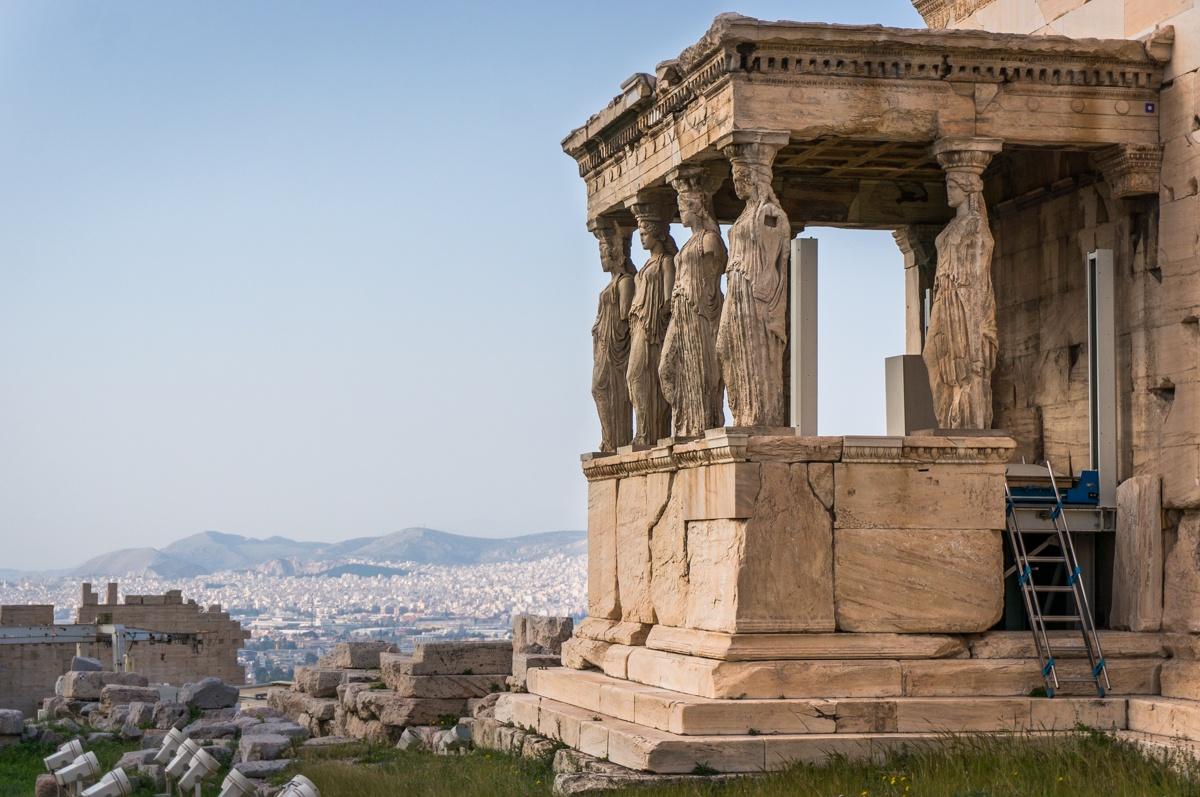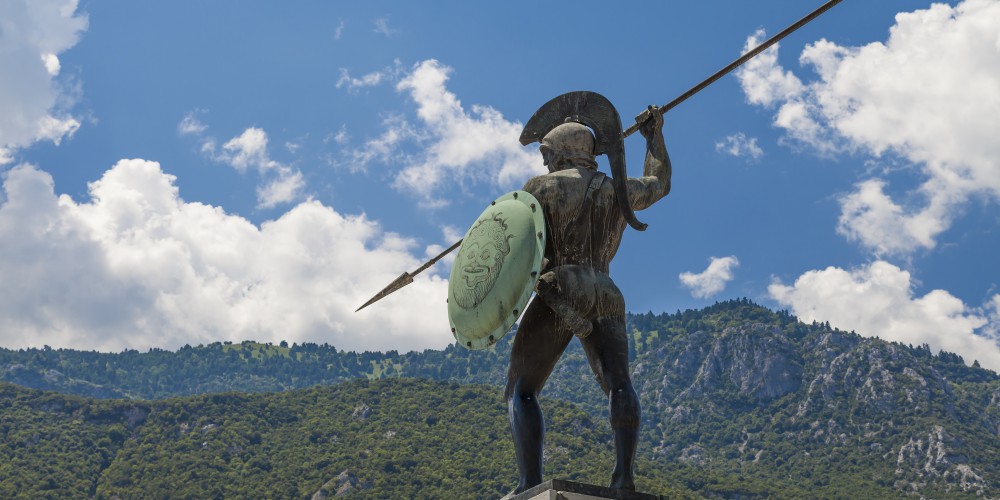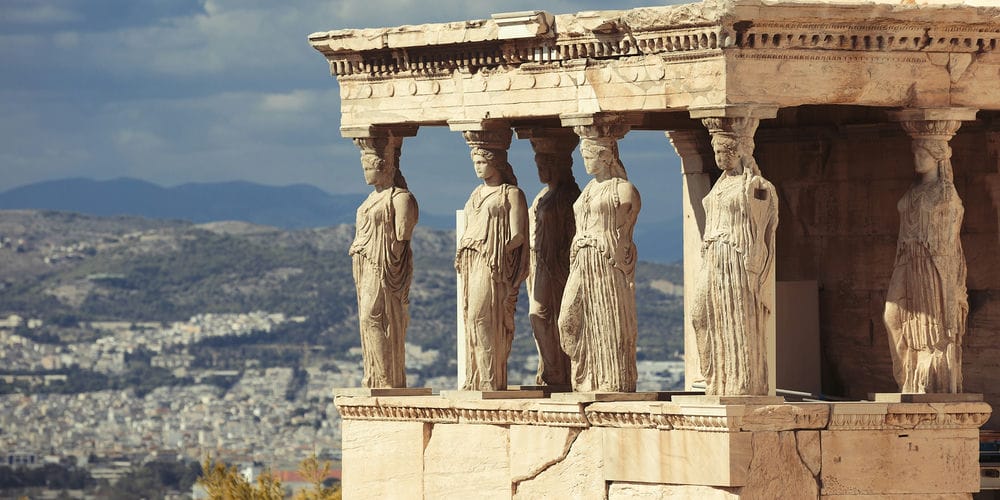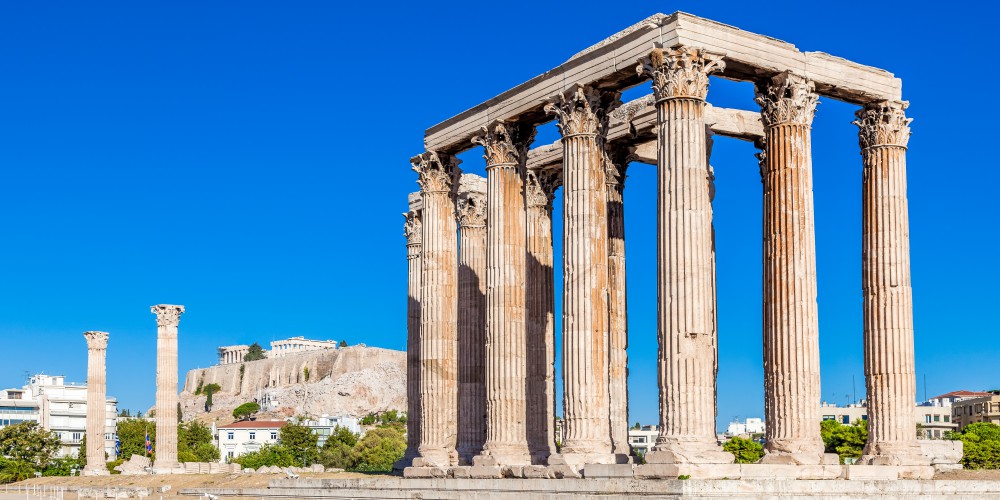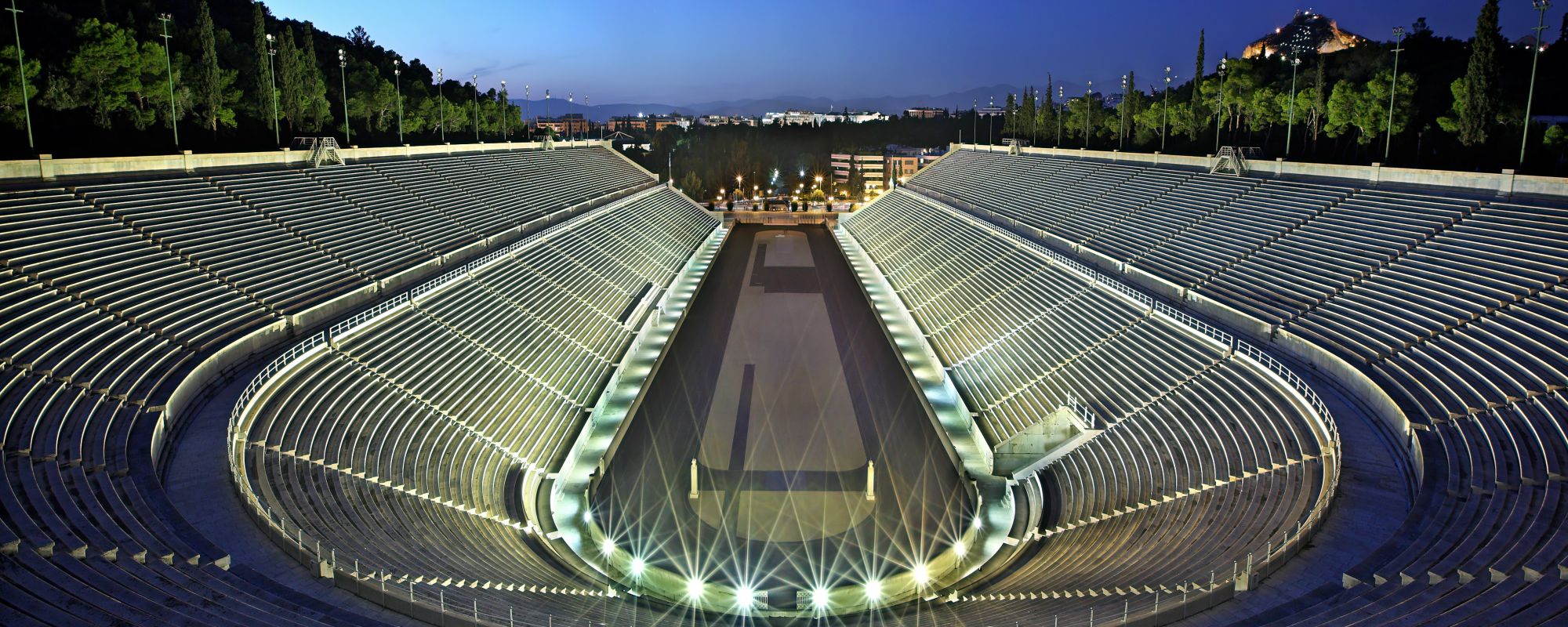
The Panathenaic Stadium In Athens: History & Visit Guide
Key Takeaways
- The Panathenai Stadium is the oldest stadium in operation in the world and a UNESCO World Heritage Site.
- The stadium was inaugurated during the Panathenaic holidays in 329 BC.
- It was the starting point of the first Modern Olympic Games in 1896.
- The general entrance admission fee costs 5 euros.
One of Athens's most significant archaeological sites lies right at the city's heart, waiting to be explored. Here you will find all details about the long history, archaeology, and how to visit this UNESCO World Heritage Site!
History Of The Panathenaic Stadium
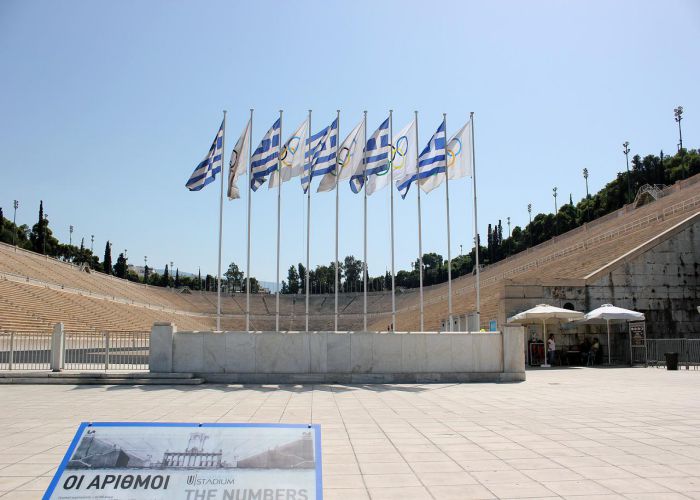
The Panathenaic Stadium is one of the most emblematic monuments of Athens and landmarks in Greece, the oldest in operation stadium in the world, and a UNESCO World Heritage Site.
It is located on the site of the ancient stadium, which was built in 338 BC, according to the initiative of the orator Lycurgus who had undertaken the regulation of the finances of Athens as well as the execution of certain public works.
The area chosen is a natural pit between the hills of Agra and Arditto, and belonged to Daneias, who granted it to the municipality of Athens for the construction of a stadium that would host the naked games of the Great Panathenea.
The name ‘stadium’ is due to the homonymous unit of length used in antiquity, which was equivalent to about 600 feet or 184.96 meters. The stadium was originally straight, and the spectators were sitting on the ground, on the slopes of the two hills.
Like any stadium of classical times, it had no propylon, and its entrance was on one side narrow. In front of the hill of Ardittos and the stadium, the sacred river Ilissos flowed.
The stadium was inaugurated during the Panathenaic holidays in 329 BC. It owes its name to Stadiou Street, which according to the original urban plan of the redevelopment of Athens, would be one of the two main axes of Athens -the other was Piraeus Street- and would connect Omonia Square, where the palaces would be built, with the stadium. This plan, although approved by Otto in 1833, never materialized.
Stadium of Lykourgos
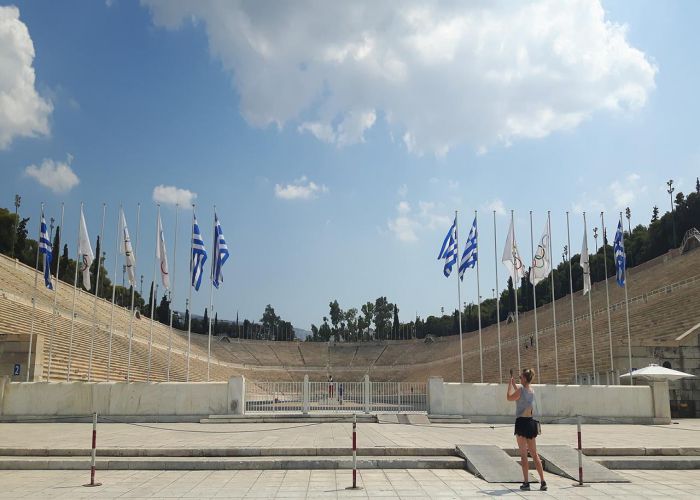
The Panathenaic Stadium is located on an ancient Greek stadium site and for many centuries hosted the organization of nude games, track and field games as we would say today.
The naked games, which were organized a long time ago in a place far from the city, were included in the program of the Panathenaic festivals in 566/565 BC.
When the orator Lycurgus took over in 338 BC., the regulation of the finances of the city of Athens included the execution of public works and the construction of a stadium.
The place was private, but the owner donated it to construct a stadium. It was made into a playing field with the characteristics of the Greek Stadium: a rectangular shape with an entrance on one narrow side and a place for spectators on the earthen slopes of the other three sides.
Reconstruction by Herodes Atticus
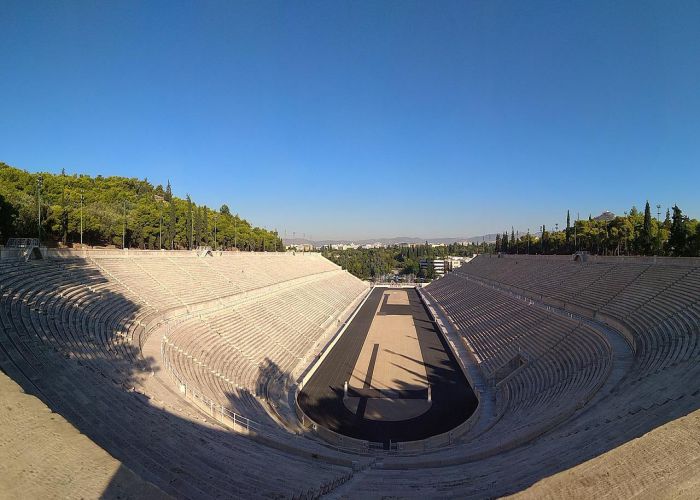
During the Roman period, and specifically the reign of Hadrian, the Stadium underwent major renovation works thanks to the generosity of the orator Herodes, son of Atticus, which lasted from 139 AD. until 144 AD and gave it the form revealed by the 1870 excavation by Ernest Ziller.
It became horseshoe-shaped, with the addition of the slingshot −the characteristic shape of the ancient Greek Stadiums during the Hellenistic times− and the space for the spectators, the theater, was divided into two moldings, and each was covered by 23 rows of seats, chairs, made of white Pentelic marble.
In the center of the sling was a row of luxurious "thrones" seats for the officials and the jury and in front of it were double-faced Hermetic columns. On the east side of the spheroidal semicircle, an underground passage led to the back of the Stadium and served for the entry and exit of the contestants and the judges, as well as the wild beasts, when it came to beast fights.
Herodes Atticus covered the entire cavity with Pentelic marble seats. The renovation was combined with Herodes' task for the Panathenaic Games of 143 AD. In fact, the Panathenaic ship of the celebration procession was placed on a long foundation on the top of the hill north of the stadium in preparation for the Panathenaic Games.
In the sling, there was a portico with Doric columns and a portico on the facade. Herodes probably renovated the bridge of Ilissos at the stadium's entrance, making it the largest, with three arches. It was visible until 1778, while part of it was discovered in an excavation in 1958.
For Herodes’ contribution to the feast, but also for his contribution to the city in general, he was awarded the honor of being buried in the stadium.
However, because this ancient information is vague, it is impossible to locate his tomb, but it was probably located either on the track or on the hill above the slingshot of the stadium, where the remains of carnivores have been found.
Abandonment
With the predominance of the Christian religion and the banning of pagan cultural events and barbaric spectacles of Roman times, such as bloody duels and beast fights, the Panathenaic Stadium lost its luster, and time took its toll. Much of its materials were removed to be used in Athenian buildings or elsewhere.
Modern reconstructions
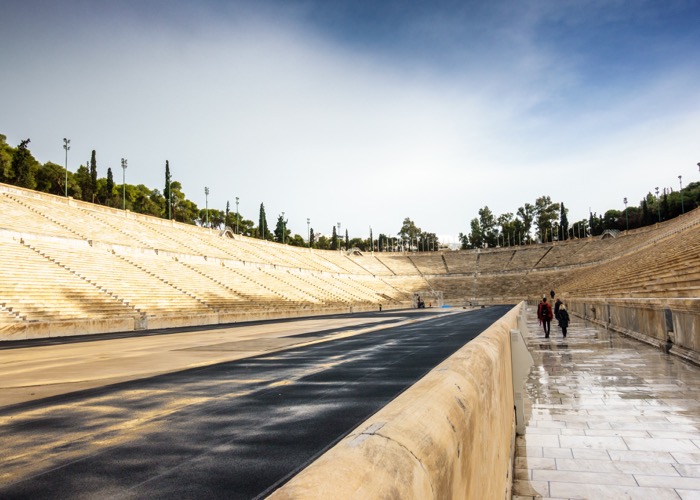
Excavations and Zappas Olympics
The revival of the Olympic Games, by the standards of the games of antiquity, was a desire that never left the Greeks.
The first serious attempt was made by the benefactor E. Zappas when in 1856, he offered to the Greek public a not insignificant amount for the organization of sports games in Athens, which were decided to take place every four years, in parallel with exhibitions of agricultural, livestock and industrial products. the "Olympia."
These games, known as the Zappas Olympics, resulted in the spread of gymnastics in Greece and the creation of gymnastics clubs. Four (1859, 1870, 1885, and 1889) were held, the second and third of which took place at the Panathinaikos Stadium, with a large participation of athletes who took part in jumping, discus, javelin, wrestling, and climbing.
1896- The first Modern Olympic Games
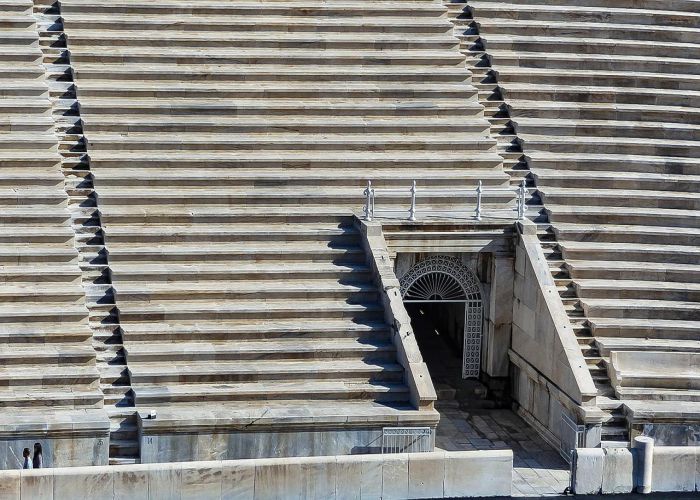
The idea of re-establishing the Olympic Games had begun to find fertile ground in Greece and Europe due to its shift towards Greek education.
With this aim and at the initiative of Baron Pierre de Coubertin, known for his ancient Greek education and belief in the ideal of sport, the International Sports Congress was organized in June 1894 in Paris.
The Panhellenic Gymnastics Association was also invited there, represented by Dimitris Vikelas, a person of special appreciation in the literary circles of Paris, who was elected President of the Conference.
The position of Pierre de Coubertin D. Vikelas managed to be accepted by the Conference his proposal for holding the first Olympic Games in Athens, a fact that caused great excitement in Greece.
Immediately, the Olympic Committee was set up, chaired by the successor Constantine and secretary general Timoleon Philemon, who undertook most of the preparation for the Games.
The reconstruction and remodeling of the Stadium were considered imperative since many of its marbles had been removed and used as a building material during the years of Ottoman rule but also before. The reconstruction was paid for by the President of the then International Olympic Committee, George Averoff, a merchant from Egypt.
The reconstruction, for which 500 people worked, was entrusted to the architect Anastasios Metaxas, who faithfully followed the design of the ancient monument of Herodes to recreate the new stadium.
In March 1895, the Olympic Committee unanimously decided to place a statue of the great benefactor, to the right of the entrance of the Stadium, as a tribute to the great sponsorship. The statue is the work of the sculptor Georgios Vroutos and the expenses were covered by the Commission.
Until the start of the first modern Olympics, only the first 4 rows were covered with white marble, and the rest of the stands were wooden, painted white, so there was uniformity, in terms of color, with the rest.
The Olympics of 1896, which began on March 25, lasted until April 3 and were a great success, with foreign correspondents writing dithyrambs both for their organization and for Greece and its inhabitants.
Then the Olympic Anthem was heard for the first time, with lyrics by Kostis Palamas and music by Spyros Samaras. There were 43 athletic competitions in which only men participated. The first Olympian was crowned on April 6, 1896, the American James Brendan Connolly, winner in the triple jump with 13.71 m.
The Greek athletes, except for Spyros Louis, won 10 victories. Spyros Louis, who had never been an athlete, was adored by the spectators when he won first place in the Olympic Marathon, covering the distance of 42.195 km in almost 3 hours, and since then has become a legend.
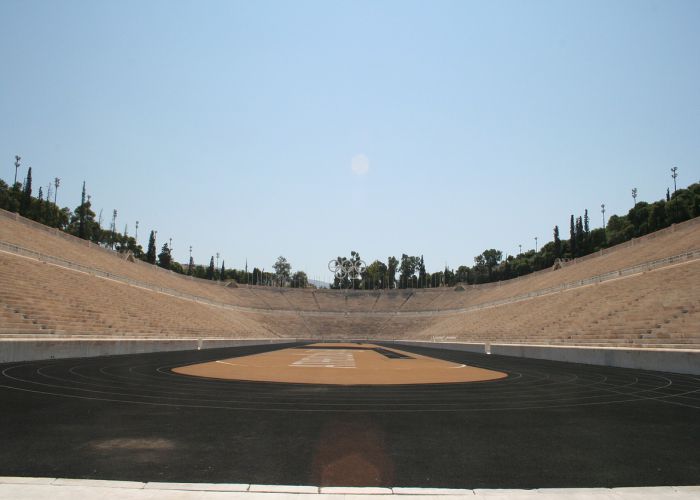
Greece has given his name to the Olympic Stadium in Kalogreza to honor him. The costume-bearer Spyros Louis, head of the Greek delegation of the Greek government at the Berlin Olympics, was the only one who did not greet fascists during the flame touch handover ceremony that took place on the 1st August 1936, at the crowded Panathenaic stadium, in the presence of A. Hitler.
The works at the Panathenaic Stadium continued immediately after the end of the Games and were completed in 1906, the year of the International Olympic Games, where then, at the request of George Averoff, Propylaea were built at the entrance of the Stadium, consisting of 18 Corinthian double rows.
However, this caused division among the Athenians, as many considered that they obstructed the unobstructed view to the inside of the stadium and did not fit into the simplicity of its form and austerity, while others argued that their grandeur was worthy of the monument.
Over time, the Propylaea suffered damage, and in 1951, the Olympic Games Committee decided to demolish them, which was completed in March 1952. At the 1896 Olympics, this underground passage was transformed into a locker room, while for the 1906 Mid-Olympics, the entrance to the passage was integrated with the locker rooms built on the east side of the Stadium.
20th century Modern Olympics
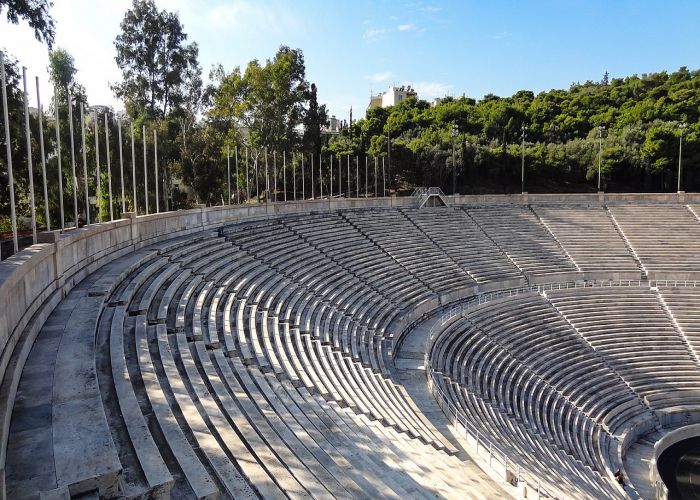
Since its establishment, the Panathenaic Stadium has hosted several sports and artistic events. Its name is inextricably linked to the world record for the largest number of spectators at a basketball game in the sport's history.
The match occurred on April 4, 1968, when a Greek team won the Cup Winners' Cup, defeating Slavia Prague in front of 60,000 spectators. In 1996, it hosted the Atlanta Olympics, and in 1997, it hosted the Opening Ceremony of the 6th World Athletics Championships. At the 2004 Olympics, the marathon and archery were completed.
Performances of ancient tragedies such as ‘Antigone’ in 1905, ‘Ekavi’ in 1927, opera performances ‘Aida’ in 1916, concerts such as the Rock in Athens Festival in 1985, Vangelis Papathanassiou in 1997, Jose Carrera in 2007, popular holidays, political gatherings Gymnastics demonstrations, and significant ceremonies, are some of the cultural events that filled and still fill the Panathinaiko Stadium.
2004 Olympics
At the 2004 Olympics, the stadium again experienced great moments with the sport of archery (15-21 / 08) but also the end of the Women's Marathon on 22/08 and the men's a week later.
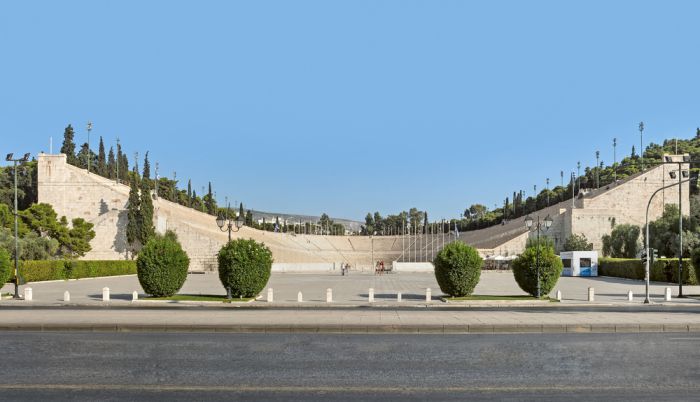
Stadium Today
Today, the Panathinaiko Stadium, with a capacity of approximately 68,000 spectators, is an important tourist Athens attraction and is used only for special occasions. It has 47 rows of seats that are divided, through a corridor, into two zones. It belongs to the Hellenic Olympic Committee, which administers, manages, and maintains it.
The Olympic flame for the Olympic Games, regardless of where they occur that year, is delivered to this Stadium.
The Hellenic Olympic Committee, guardian of Olympism in our country, decided to make the Stadium a place to visit. This offers the possibility of touring the area to all visitors, Greeks, and foreigners, as well as the possibility of organizing sports activities and educational visits for children and students.
Every visitor now has the opportunity to walk around the Stadium, be guided in its premises, enter the Roman gallery, run in the stadium, and know its history. Thus, visitors are informed about the rich history of the Panathenaic Stadium and the history of its white marble construction, restoration, architecture, and location.
There is a traditional cafe at the entrance of the Stadium. The future plans of the Hellenic Olympic Committee are the creation of a Museum and a souvenir shop.
The goal of the Hellenic Olympic Committee is to establish the Panathinaiko Stadium as one of the main poles of tourist interest in Athens but, simultaneously, a place of recreation for the residents of the capital.
How To Visit The Panathenaic Stadium
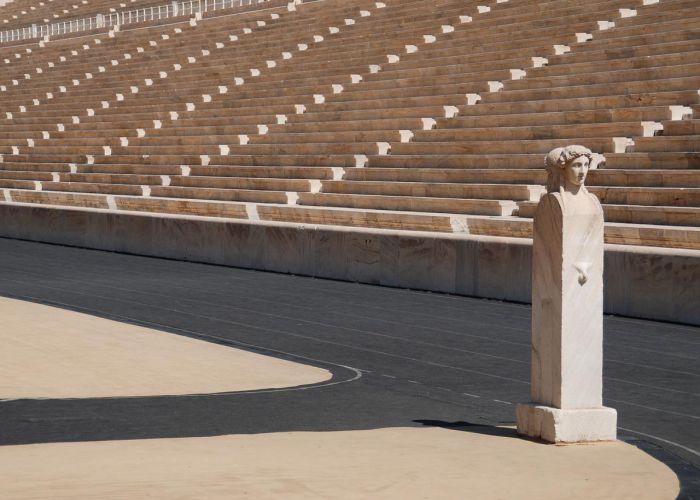
The Panathenaic Stadium is located very close to the center of Athens; therefore, it is quite easy to reach by any means of transport.
The nearest metro station is that of Syntagma, about 800 m away, while right in front, on Vassileos Konstantinos Avenue, you will come across the buses of lines 209 and 550, the trolleys 2, 4, 10, and 11 - 'Stadio' stop- and T4 and T5 of the tram - 'Mets' stop. The main entrance to the horseshoe area is located on Archimidous Street, at the back of the Panathenaic Stadium.
From the front side, the access to the specific point is through the small Agras street that follows the stairs that are next to the left side of the Stadium (point B), while from the side of the neighborhood of Pagrati, it is made from Archimedous street.
Where Is The Stadium Located?
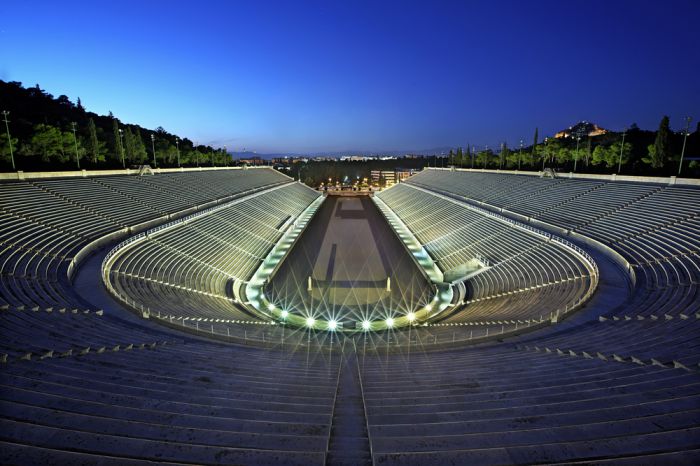
The Panathenaic Stadium, also known as Kallimarmaro, is a stadium in Athens located east of Zappeion and north of the hill of Ardittos, through which the Ilissos River passes.
Admission
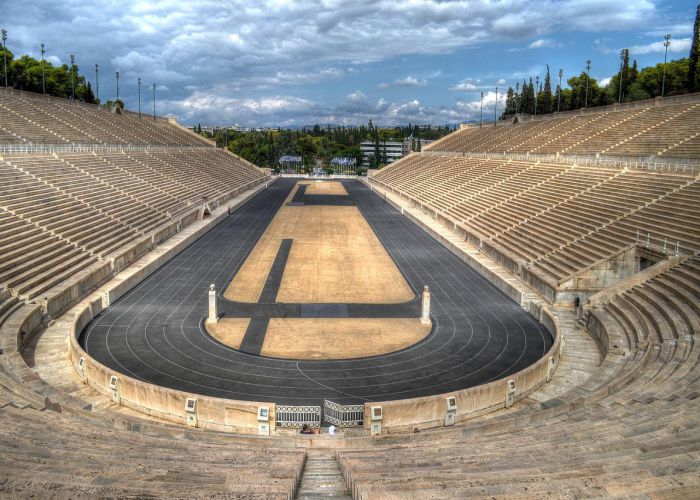
The Panathenaic Stadium is open to the public from March to October from 08:00 am to 19:00 pm, with the last ticket issued at 19:00. While from November to February, it is open from 08:00 am to 17:00 pm, with the last ticket issued at 17:00.
The general entrance admission fee costs 5 euros. The reduced admission for students with a student ID comes up to 2.50 euros. People with disabilities and children up to 6 years old can enter the site for free.
Fun facts about the Panathenaic Stadium
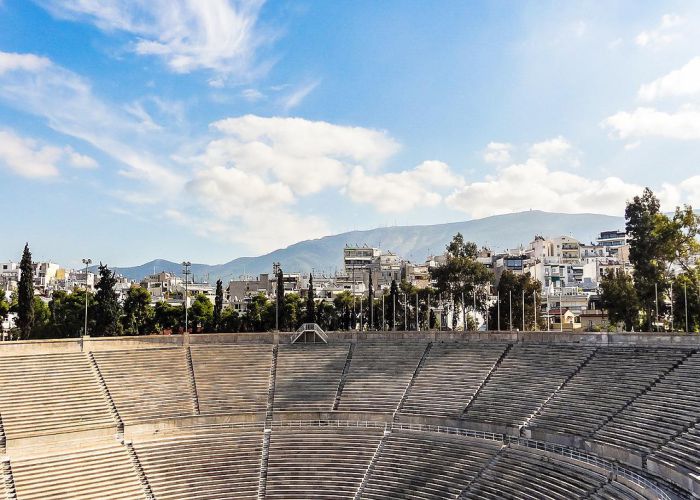
- It is the oldest operating stadium in the world. His age is estimated to be 2,352 years.
- It is the only stadium in the world where three Olympic Games have been held.
- It is also the only one in the world which is made entirely of white Penteli marble. The quarries were opened before the 1896 Olympics exclusively for its construction.
- In Roman times, it was used as an arena with the addition of a semicircular wall.
- He holds another world record that will probably remain unbroken forever. It concerns the largest attendance of spectators at a basketball game in the history of the sport.
- The Ilissos river flowed in front of the stadium until a few decades ago. A beautiful bridge connected the entrance of the stadium with Herodes Atticus. Today the river is underground.
Final Thoughts
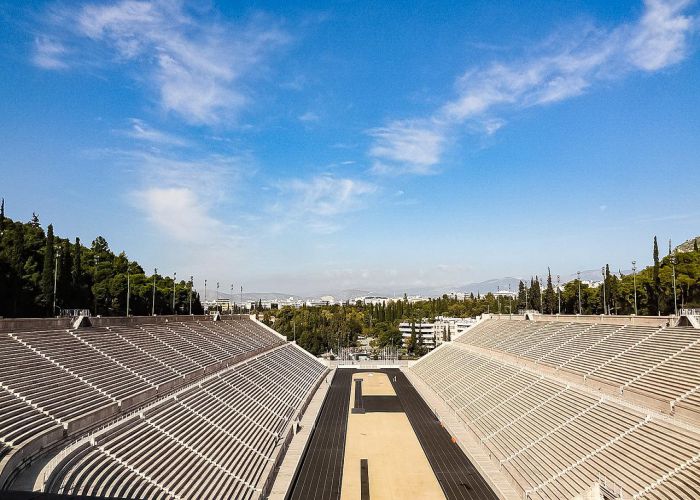
As you have probably realized by now yourselves, the Panathenaic Stadium hides a world of history within its premises. It is a sight of beauty and a trademark of the Greek capital that is deeply embedded in Athenian history and culture.
Now that you know all about it, it’s time to visit it during your experience with one of our Greece vacation packages and see what the hype is all about!
Frequently Asked Questions
What does 'Panathenaic' mean?
Where is the original Olympic stadium?
Can you run in the Panathenaic Stadium?
Why was the Panathenaic Stadium built entirely of marble?
